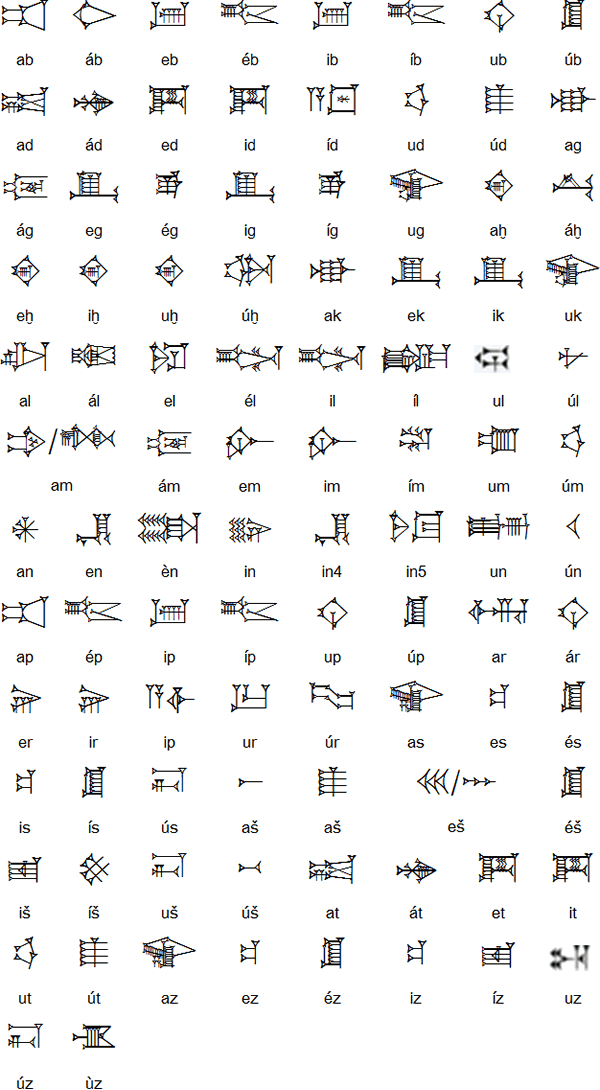Sumerian was spoken in Sumer in southern Mesopotamia (part of modern Iraq) from perhaps the 4th millennium BC until about 2,000 BC, when it was replaced by Akkadian as a spoken language, though continued to be used in writing for religious, artistic and scholarly purposes until about the 1st century AD. Sumerian is not related to any other known language so is classified as a language isolate.
Sumerian cuneiform is the earliest known writing system. Its origins can be traced back to about 8,000 BC and it developed from the pictographs and other symbols used to represent trade goods and livestock on clay tablets. Originally the Sumerians made small tokens out of clay to represent the items. The tokens were kept together in sealed clay envelopes, and in order to show what was inside the envelopes, they press the tokens into the clay in the outside.

Examples of the clay tokens
Over time they realised that the tokens were not needed as they could make the symbols in the clay. They also developed a numeral system to represent multiple instances of the same symbol rather than just inscribing them all. The symbols became stylised over time and eventually evolved into a complete writing system. The earliest texts come from the cities of Uruk and Jamdat Nasr and date back to 3,300BC.
The name 'cuneiform' means 'wedge-shaped' and comes from the Latin cuneus (wedge). It is based on the appearance of the strokes, which were made by pressing a reed stylus into clay. These type of symbol emerged in 3,000 BC.
By about 2,800 BC some of the Sumerian glyphs were being used to represent sounds using the rebus principle. For example, the symbol for arrow, pronounced 'ti', was used to represent the word for life (til). There were also many glyphs which were pronounced the same but represented different words. Later a system of determinatives, which gave you a hint at the category a word belonged to, and of phonetic components, which indicated how to pronounce a word, developed, and helped disambiguate the meanings of glyphs.
Here are some examples of how glyphs changed over time:

Source: http://pandora.cii.wwu.edu/vajda/ling201/writingsystems/sumeriancuneiform.htm


Source: https://en.wikipedia.org/wiki/Cuneiform

Summary account of silver for the governor written in Sumerian Cuneiform on a clay tablet. From Shuruppak, Iraq, circa 2500 BC. British Museum, London.
Image by Gavin.collins - http://commons.wikimedia.org/wiki/File:Sumerian_account_of_silver_for_the_govenor.JPG
Information about the Sumerian language and script:
http://en.wikipedia.org/wiki/Cuneiform_script
https://en.wikipedia.org/wiki/Cuneiform
http://en.wikipedia.org/wiki/Sumerian_language
http://www.sumerian.org/
Sumerian dictionaries
http://psd.museum.upenn.edu/
http://www.sumerian.org/sumerlex.htm
The Sumerian Word of the Day
http://sumerianwotd.livejournal.com/
Adaizan, Ainu, Basque, Burushaski, Candoshi-Shapra, Chitimacha, Eskayan, Hadza, Haida, Karuk, Kawésqar, Keres, Kuot, Kusunda, Kutenai, Natchez, Nihali, Nivkh, Páez, Purepecha, Sandawe, Seri, Sumerian, Tartessian, Ticuna, Tiwi, Tonkawa, Tunica, Urarina, Waorani, Warao, Wardaman, Washo, Yaghan, Yele, Yuchi/Euchee, Zuni
Akkadian, Elamite, Hittite, Old Persian Cuneiform, Sumerian, Ugaritic
Akkadian Cuneiform, Ancient Egyptian (Demotic), Ancient Egyptian (Hieratic), Ancient Egyptian (Hieroglyphs), Chinese, Chữ-nôm, Cuneiform, Japanese, Jurchen, Khitan, Linear B, Luwian, Mayan, Naxi, Sawndip (Old Zhuang), Sui, Sumerian Cuneiform, Tangut (Hsihsia)
Page last modified: 31.08.24
[top]
You can support this site by Buying Me A Coffee, and if you like what you see on this page, you can use the buttons below to share it with people you know.

If you like this site and find it useful, you can support it by making a donation via PayPal or Patreon, or by contributing in other ways. Omniglot is how I make my living.
Note: all links on this site to Amazon.com, Amazon.co.uk
and Amazon.fr
are affiliate links. This means I earn a commission if you click on any of them and buy something. So by clicking on these links you can help to support this site.
[top]